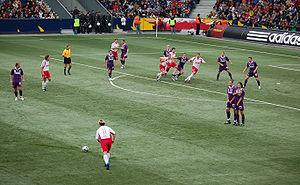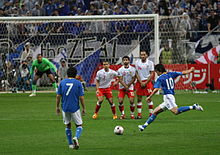- Direct free kick
-
A direct free kick is a method of restarting play in a game of association football following a foul. Unlike an indirect free kick, a goal may be scored directly against the opposing side without the ball having first touched another player.
Contents
Award
A direct free kick is awarded to the opposing team when a player commits a penalty foul, for example, pushing or tripping an opponent.[1] However, if the offence was committed by the defending team within their own penalty area, the kick becomes a penalty kick.
Procedure
The kick is taken from where the foul occurred, unless that was within the fouled team's goal area, in which case it may be taken from anywhere within the goal area. The ball must be stationary prior to being kicked. Opponents must remain 9.15 metres (10 yards) from the ball (and also outside of the penalty area if the kick is taken from within the defending team's penalty area) until the ball is in play. Observed the distance, the opposite players may choose to form a "wall" between the ball and the goal.
In order to keep the initiative a quick free kick is sometimes taken without waiting for the opposing players to retire from the 9.15 m (10 yard) radius.
The ball becomes in play as soon as it is kicked and moves, unless the kick was taken from within the kicking team's penalty area, in which case it is in play once it has passed directly beyond the penalty area.
A goal may be scored directly from a direct free kick, but only against the opposing side (i.e. an own goal may not be scored). However, should the ball directly land in the own goal, a corner kick is awarded to the opposing team. A player may be penalised for an offside offence committed from a direct free kick.
Scoring opportunities
There are three primary techniques used with direct free kicks. First, the player taking the direct free kick may blast the ball as hard as he can, usually with the laces of the boot. Alternatively, some players try to curl the ball around the keeper, with the inside of the boot. Additionally, certain free kick specialists will choose to kick the ball with minimal spin, making the ball behave unpredictably in the air. Free kick takers may also attempt to cross the ball to their centre backs or strikers in order to get a header on goal, especially if the position of the free kick is close to the wings.
Infringements
Opposing players must retire the required distance as stated above. Failure to do so may constitute misconduct and be punished by a caution (yellow card).
It is an offense for the kicker to touch the ball a second time until it has been touched by another player; this is punishable by an indirect free kick to the defending team from where the offense occurred, unless the second touch was also a more serious handling offense, in which case it is punishable by a direct free kick or penalty kick, as appropriate.
Strategy
Most teams have one or two designated free kick takers, depending on the distance from goal and the side of the field the free kick is to be taken from. The strategy may be to score a goal directly from the free kick, or to use the free kick as the beginning of a set play leading towards a goal scoring opportunity.
Where there is a potential for a dangerous shot on goal to occur from a direct free kick often the defending side erects a "wall" of players standing side-by-side as a barrier to the shot. A kicker who has the skill to curl the ball around a wall is at a distinct advantage.
Select players known for their extraordinary skill in this special form of kicking ability have been Thierry Henry, Robin van Persie, Ronald Koeman, Zico, Johan Neeskens, Andrea Pirlo, Roberto Carlos, Juninho, Shunsuke Nakamura, Rivaldo, Rogério Ceni, Alessandro Del Piero, Wesley Sneijder, Sebastian Larsson, David Beckham,and Ronaldinho .
Another strategy for free kicks is to "knuckle" the ball by hitting it on the top of the foot so it will go over the wall then dip immediately towards goal. Footballers known for this style are Juninho, Cristiano Ronaldo, Nelinho, Sebastian Larsson, Didier Drogba and Keisuke Honda.
See also
References
- ^ "When is a direct free-kick awarded?". BBC Sport. September 1, 2005. http://news.bbc.co.uk/sport2/hi/football/rules_and_equipment/4200940.stm. Retrieved December 17, 2009.
Laws of the Game - Rules of Association football Terms Law 1: The Field of Play · Law 2: The Ball · Law 3: The Number of Players · Law 4: The Players' Equipment · Law 5: The Referee · Law 6: The Assistant Referees · Law 7: The Duration of the Match · Law 8: The Start and Restart of Play · Law 9: The Ball In and Out of Play · Law 10: The Method of Scoring · Law 11: Offside · Law 12: Fouls and Misconduct · Law 13: Free kicks (direct and indirect) · Law 14: The Penalty Kick · Law 15: The Throw-In · Law 16: The Goal Kick · Law 17: Corner kickInternational Football
Association Board (IFAB)External links
Categories:- Laws of association football
- Association football tactics and skills
Wikimedia Foundation. 2010.



